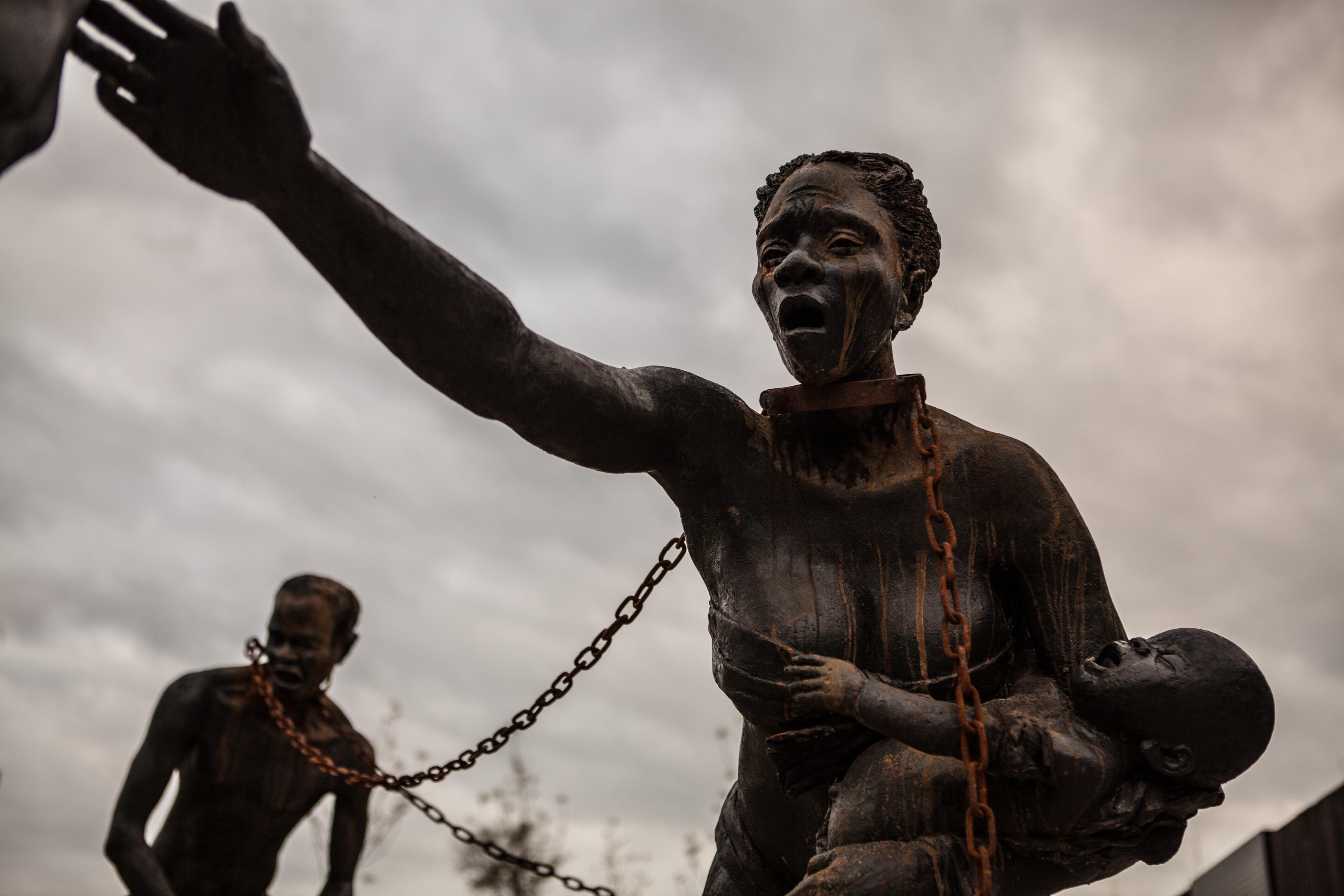
Sculpture by Kwame Akoto Bamfo at the Equal Justice Initiative Legacy Museum, Montgomery, Alabama. Wikipedia
“There would be no United States as we now know it today without slavery. That is a simple and basic truth.”
—Bob Avakian, BAsics 1:1
Dear Revolution:
Recently, I took a short trip to Montgomery, Alabama. The city is full of reminders that you’re in the state George Wallace, the most infamous in a long line of Alabama’s openly and violently white supremacist governors, once called the “very Heart of the great Anglo-Saxon Southland.” A sign on Interstate 85 in central Montgomery announces an exit for the first Confederate White House. A block north of that foul monument to slavery is the Alabama State Capitol—where, in 1963, as the Civil Rights movement gathered strength and momentum, Wallace bellowed “segregation today, segregation tomorrow, segregation forever” to a racist mob.
But that same exit also takes you to a unique, heartfelt, and unforgettable presentation of the horrors at the core of the history and current reality not just of Alabama, but of this entire country.
In 2018, after decades researching, developing, building, commissioning and collecting art, the Equal Justice Initiative (EJI) opened the Legacy Museum: From Enslavement to Mass Incarceration. About a mile away, it opened the National Memorial for Peace and Justice, an outdoor memorial with more than 800 steel columns marking locales where lynchings occurred, and inscribed with the names of more than 4,000 known lynching victims. A waterfall on one side of the Memorial is dedicated to unknown victims. Freedom Monument Sculpture Park is scheduled to open early in 2024, on a nearby bluff overlooking the Alabama River. The three are the EJI’s “Legacy Sites,” and together they “tell the story of slavery in America and its legacy through interactive media, first-person narratives, world-class art, and data-rich exhibits.”
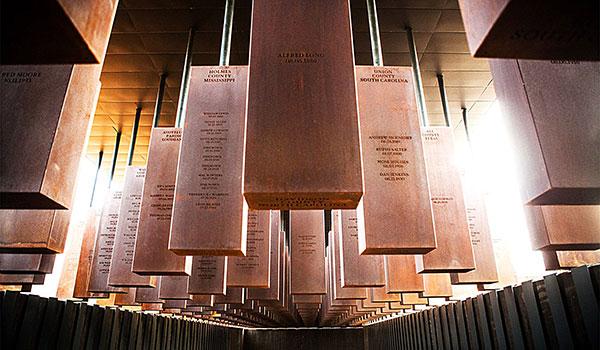
National Memorial for Peace and Justice, Equal Justice Initiative Museum, Montgomery, Alabama. More than 4,400 Black people killed in racial terror lynchings between 1877 and 1950 are remembered here.
The Legacy Sites are a stunning achievement. A visit to them can be overpowering. The day I spent in the Museum and on a slow walk through the Memorial left me emotionally drained, exhausted, and filled with fury. I wasn’t the only one who, after leaving the museum, took advantage of a park next to it, which encourages visitors to engage in reflection, to begin to absorb and process what they have just encountered.
A previous article in Revolution describes much of what went into the development of these sites, and the EJI website provides a glimpse of some of the exhibits. In this letter I’m going to touch on just a few of them.
Even when you think you know something of the real history of this country, you’ll learn things that can jolt you at these sites. Some examples for me: Massachusetts was the first colony to legalize slavery; ships from Providence and other Rhode Island cities dominated the trans-Atlantic slave trade; at the time of the U.S.’s founding, almost half the households in New York City owned slaves.
But the museum and memorial are deeper and richer than a mere presentation of facts and information. Visiting these sites is a gut-wrenching, painful experience. No one rushes through them. I overheard people quietly talking about the number of lynchings in the South Carolina county they live in. Another couple with adolescent children was looking for the name and story of a relative from Florida who they thought was lynched in the early 20th century.
People stare for long moments, sometimes sobbing, at photos, images, displays, and art. People linger to engage with some of the interactive art, and watch short films on topics like Reconstruction, mass incarceration, the Montgomery bus boycott, and others shown in several small theaters.
From Enslavement to Mass Incarceration
The Legacy Museum takes a visitor on a journey that brings alive the trajectory of a country that calls itself “the land of the free.” When you enter the museum, you are confronted with a powerful, even terrifying, video of a turbulent ocean. Sculptures then portray the horrors and deaths millions faced on the “Middle Passage”—the journey across the Atlantic in packed slave ships. As you go through the exhibits, you travel through hundreds of years of slavery, through the terrors of lynch mobs and the degradation of Jim Crow segregation, and conclude in the era of mass incarceration.
For about 250 years, almost all Black people in this country were the property of white people! In 1857 the U.S. Supreme Court decreed that a Black man has no rights a white man is bound to respect. For 100 years after the Civil War ended, “lynch law” reigned in the South. Thousands of Black people were murdered in town squares, in broad daylight, by depraved, howling racist mobs, and often the dismembered bodies of the victims were sold as “souvenirs.” This too was upheld by the U.S. Supreme Court. Today millions of Black people are imprisoned, and Black people are being killed by murdering police at a far higher rate than were murdered by lynch mobs in the Jim Crow era—also enforced and upheld by courts across the country.
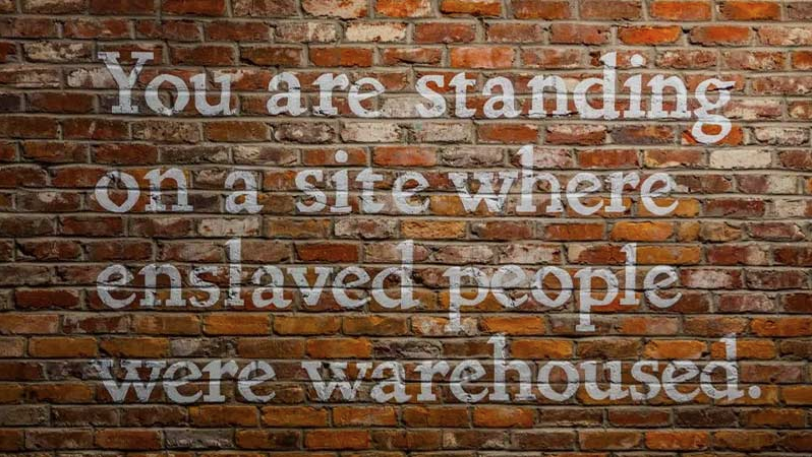
Visiting The Legacy Museum, Montgomery, Alabama Equal Justice Initiative
These words on a brick wall inform museum visitors of Montgomery’s slave trading history: “You are standing on a site where enslaved people were warehoused.” When you turn the corner, a narrow, dimly-lit hallway is lined with “holding pens” like those used to imprison people before they were put on the auction block. Shadowy, ghost-like apparitions seem to be in each pen. But when a visitor approaches the cell’s bars, the apparition inside takes shape as the hologram of an imprisoned slave, and begins speaking. The words are usually taken from actual statements made by formerly enslaved people. In one pen, a woman sings a haunting, mournful song. In another are a boy about 10 and his younger sister. When someone presses up against the bars to see them, they start slowly swaying. The boy puts his hand on his sister’s shoulder, and quietly says “Mama. Mama. She needs her mama.”
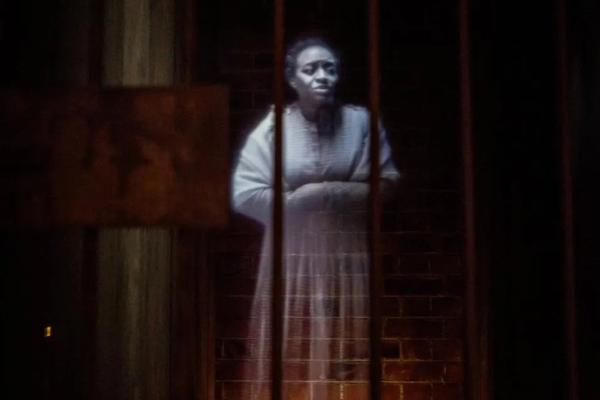
Holographic Slave Image Equal Justice Initiative
A large room contains wrenching stories of people like Laura Nelson, a woman who, along with her 12-year-old son, was hung from a bridge in Oklahoma and left there for days while photographs of them were turned into postcards. This room also has a wall filled with a montage of headlines from newspapers across the South announcing time and place of lynchings—gruesome spectacles that large numbers of white people reveled in and celebrated. For over a century the highest courts and political authorities in the country repeatedly said they were “powerless” to stop the murder of Black people taking place openly, and on a mass scale.
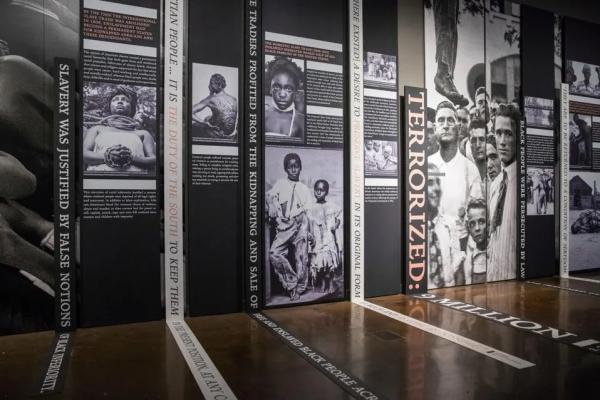
History of slavery wall Equal Justice Initiative
In the “prisoner gallery,” visitors can sit at a table, shoulder to shoulder with other visitors. A different prison inmate is on the other side of a window from each of them. When the visitor picks up a phone, each inmate speaks to them directly, telling of the injustice and cruelty of their arrest, conviction, and incarceration, and the despair of life without hope. Their condition of suppression, confinement, and forced labor seems little changed from the outright enslavement of those in the holding pens.
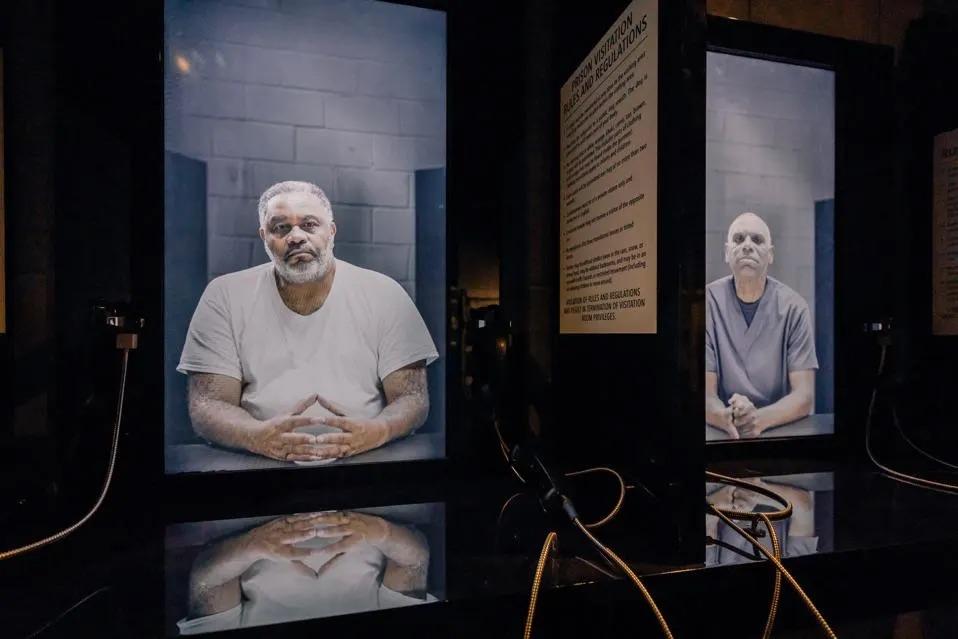
Prisoner gallery at the Legacy Museum Equal Justice Initiative
Changing Forms of a Deepening Oppression
The museum also features interactive displays that powerfully illustrate the enormous amount of wealth wrenched from the labor of Black people and accumulated by slaveowners and capitalists. First, from slaves working on the tobacco and rice plantations of Virginia and the Carolinas. When the U.S. gained its independence from England, nine of the ten wealthiest people in the country were owners of massive slave plantations and lived in Charleston, South Carolina.
Other rooms vividly bring home how the rapid expansion of slavery into the cotton growing regions of the South was an engine that drove the development of capitalism in England and the Northern U.S. Unprecedented fortunes were accumulated from the “whipping machine” of slavery along the deltas of the Mississippi and other southern rivers. Banks and insurance companies whose modern-day incarnations include JPMorgan Chase, Citi Group, and Wells Fargo had origins in profits from the wealth produced by slaves.
Today’s capitalists have intensified their unending search for maximum profits to the oppressed regions of the world; they and their system no longer have a use for masses of Black youth. And for decades, mass criminalization and incarceration has been inflicted on generations of Black and Brown youth.
It is an indictment of this country that so much of the history on display in the EJI facilities is not known by most people. The realities of deeply embedded, systematic, and intensifying oppression of Black people in this country have largely been whitewashed out of the school books. Now, even recognizing or mentioning that slavery was essential to the establishment of the U.S., and “legitimized” in its founding documents, is under attack by Republican fascists.
It is an indictment of the country’s dominant morality that monuments and museums like the ones in Montgomery aren’t everywhere, and that it took so long and so much effort to build them. Everyone who can should try to make a trip to Montgomery and experience the Legacy sites themselves.
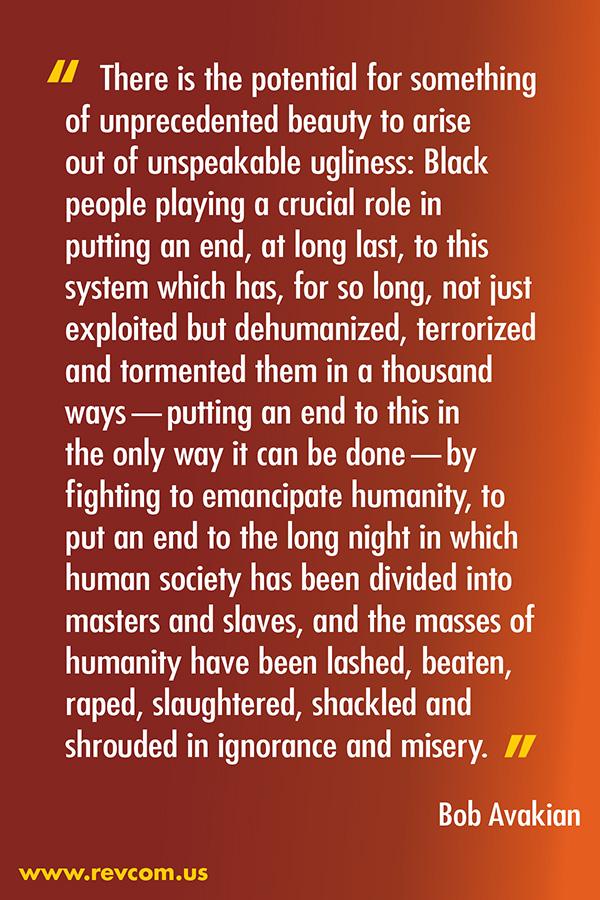
Getting to the Root of the Problem
The EJI’s website says, “the Power of History is in Telling the Truth.” Important as telling the truth is, it must be understood scientifically, so it can be radically transformed. Being scientific means getting to the root of the problem. The Legacy Sites powerfully and artistically depict the truth that for over 400 years, while the oppression of Black people has changed in some of its forms and expressions as the underlying ways of producing society’s wealth changed—it has become ever more deeply embedded as a defining feature of U.S. society. This oppression can be changed only by getting to the root—through an actual revolution that overthrows the system it is embedded in, and building a new society, based on the Constitution for the New Socialist Republic in North America, written by Bob Avakian (BA).
Right now, the rulers of the U.S. are at each other’s throats in an all-out fight. This fight is tearing apart the forms and institutions that have cohered this country since the end of the Civil War. One side, the Democrats, has for decades advocated and built programs of mass incarceration and virtually unrestrained violence against Black people, even as they mouth phrases about “justice,” and “inclusion,” and even if many of the perpetrators of that violence today are themselves Black, like the Memphis cops who murdered Tyre Nichols. The other side, the Republi-fascists, advocate totally unrestrained brutality and murder of Black and Brown people, forbidding even mention of the word slavery in studying U.S. history, and the complete and open domination of white supremacy.
But their titanic conflict is bringing about conditions in which revolution to overthrow the entire system they both represent, the system that for centuries has spawned atrocities like those so powerfully depicted at the Legacy Sites, is more possible.
We must not waste any time in doing everything possible to make that possibility a reality. As Bob Avakian wrote,
There is the potential for something of unprecedented beauty to arise out of unspeakable ugliness: Black people playing a crucial role in putting an end, at long last, to this system which has, for so long, not just exploited but dehumanized, terrorized and tormented them in a thousand ways—putting an end to this in the only way it can be done—by fighting to emancipate humanity, to put an end to the long night in which human society has been divided into masters and slaves, and the masses of humanity have been lashed, beaten, raped, slaughtered, shackled and shrouded in ignorance and misery.
